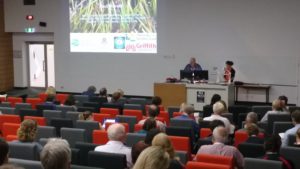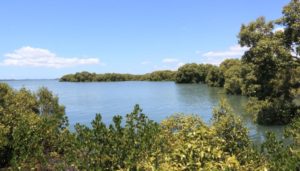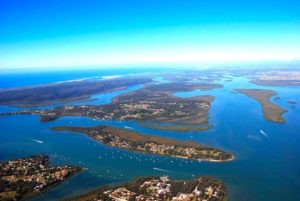

Broad-fronted mangrove crab at Toondah Harbour in Moreton Bay Photo: Chris Walker
Twenty years ago scientists, planners, and politicians met to discuss the plight of Moreton Bay.
The findings of the Moreton Bay and Catchment Conference showed there was a great gap between the science (or evidence) and the planning and management of the Bay and its catchment.
Two decades later a second forum, the Moreton Bay (Quandamooka) and Catchment Forum 2016 (MBQC 2016) was convened. Sadly it has identified the lack of progress since 1996.
Indeed, the gap between the scientific understanding of the bays needs and the Government’s planning has probably widened! A mere word count for ‘Moreton Bay’ in the draft SEQ Regional Plan, Shaping SEQ shows there is no reference to the importance of the Bay to the region’s livability, sustainability or quality of life. It ignores that the region’s projected growth (as being promoted by the new Plan) will impact the Bay and the ecosystem services it provides to people of SEQ.
The 1996 Conference
The inaugural Moreton Bay and Catchment Conference took place at the University of Queensland in December 1996. It was followed by the publication of an excellent record of the proceedings – Moreton Bay and Catchment.
The 1996 book concludes with the chapter “Towards a Comprehensive management Plan for the Moreton Bay Subregion”. This chapter integrates what was needed to manage Moreton Bay (the Bay). It also highlights the bays immense scientific, economic and cultural significance for Queensland, and which provides settlement, a reservoir of resources and a sink for the disposal of waste.
At the time concern was being expressed for the impact of past and current land and water use activities, the sustainability of current practices and the carrying capacities of various natural systems within the Bay. The requirements to safeguard the Bay’s resources and to provide opportunities and options for future generations were viewed as paramount. The focus and scrutiny of Bay utilisation came from many quarters, including many scientific and professional bodies.
The concluding chapter put forward the planning framework based on the following princples:
- It should embrace a regional setting which allows the inclusion of all elements and issues of all elements and issues of regional significance;
- The scope of the study should be comprehensive and multidisciplinary and it should embrace the biophysical and socio-cultural elements of the marine and the terrestrial environments of the Bay;
- Planning considerations need to be based on scientific knowledge;
- The underlying planning philosophy should embrace the environmental planning principles of diversity, sustainable development, environmental carrying capacity, equity and the precautionary principle;
- The planning study area should approximate a natural area, and be delineated on the basis of an ecosystems or biophysical approach, without regard to the existing legislative and administrative arrangements;
- It should be a democratic and participatory process that facilitates the maximum involvement of all stakeholders;
- Future planning should promote a cooperative approach that involves the community at all levels of government in partnership arrangements;
- It must be capable of resolving conflicts, but more importantly managing potential conflicts before they arise;
- It should be an open and transparent planning process that achieves and retains the confidences of all participants
- It should be capable of producing a viable range of alternative options
The 2016 Moreton Bay Forum

Moreton Bay Forum 2016
The outcomes of the 2016 Forum are still being compiled. But the contributions were made in ten research clusters, each comprising topics relevant to a sustainable Moreton Bay and catchment. The groups of experts, drawn from research, education and industry institutions, compiled the latest knowledge on Moreton Bay and its catchment. The Forum was convened by Associate Professor Ian Tibbetts from the University of Queensland and ran from the 1st to 3rd November 2016. A distinguished cohort of academics and researchers supported the Forum as members of the Advisory Committee, as Cluster convenors and presenters.
All up some 75 speakers, most by way of “Lightning Talks”, provided snappy overviews of the latest research projects in and around Moreton Bay. About 150 scientists, government employees, industry representatives, educators and the public attended the forum. The obvious absentees were representatives of the local governments within the SEQ Region.
The impressive presentations (collated into clusters) will soon be released, including priorities and recommendations for action. This MBQC2016 web site is now being re-developed to provide a platform for post-forum action, news and discussion.
The presentation clusters comprised:
Indigenous Culture : acknowledges the Traditional Owners of the Bay being the principal geographic focus for the Forum, i.e. the waters of Moreton Bay, its associated islands, the immediate coast and estuaries. This cluster seeks to articulate and advance the crucial implications of the Aboriginal Peoples’ connection to Country relationship and the imperative for it to receive greater recognition than hitherto in planning, management and governance arrangement for Moreton Bay
Water Quality and Land-Use : establishes and synthesises observed changes in the land-cover and land-use of the Moreton Bay catchment over the past 40 years, along with observed variations in water quality.
Habitats, Biodiversity and Ecosystem Function : A synthesis of research in Moreton Bay habitats, its biodiversity and the functioning of ecosystems within the bay. Individual chapters
will be focussed on the dominant ecosystems in the bay and important groups of organisms and their ecological roles in the bay.
Industry : The focus is on four industries: tourism, fishing (recreational, commercial, indigenous, aquarium and coral), aquaculture and transport; and summarises the historical context, current status, and examines the future opportunities and potential risks for industry and the environment.
Citizen Science : Discusses the role, outcomes and applications of coastal and marine citizen science initiatives in Moreton Bay and some case studies that demonstrate how citizen science has contributed to understanding regional marine habitats and wildlife.
Education and Research Infrastructure: examined aspects relating back to the role of education in ensuring communities value the diversity and importance of beautiful Moreton Bay.
Moreton Bay Marine Park investigates the values of MBMP stakeholders and the current human uses of the park. The influence of the MBMP on the ecological communities of the Bay and the economic implications of the park .
Communities and Values : The focus was on the the importance of waterways in southeast Queensland to residents and the economy.
History and Change : looks at the history of Moreton Bay and its catchments, assesses how the Bay has changed since first European settlement and what impact this has had on its current state.
Planning : draws upon the outputs of other clusters to derive options for the management of the key economic, social and ecological issues of Moreton Bay and its catchments.
Shaping SEQ
The draft SEQ Regional Plan, Shaping SEQ is currently asking people to “Have your say” until 3 March 2017. Unfortunately the opportunity was lost for those responsible to drafting the new SEQ Regional Plan to inform this significant scientific forum.
The focus of the Forum was on the importance of Moreton Bay and waterways in southeast Queensland to residents and the economy, relevant understandings to help shape SEQ. Participants generally however had little knowledge of the recently released draft SEQ Regional Plan: ShapingSEQ.
Conversely, the draft Plan references to “Moreton Bay” (50 in all) are usually about the Moreton Bay Regional Council (by name), locations of photographs and some references to specific locations.
The draft Plan currently ignores much of the planning principles learnt in 1996. There is no reference to the central functions of the Bay in providing for settlement, a reservoir of resources and a sink for the disposal of waste. It shows no clear link or pathway between catchment management, natural resource management or myriad other plans and strategies of the SEQ Region.
Importantly the draft Plan has no clear reference of response to the threats posed by population growth and the pending urbanisation of the catchment of the Bay from the roll out of ShapingSEQ.
Looking Forward
The challenges posed in the 1996 Conference as outlined in the planning framework and the chapter Towards a Comprehensive management Plan for the Moreton Bay Subregion remain unchallenged.
Isn’t it time that the region enjoyed a “joined up” planning approach. As it is, the growth projections and the current draft Shaping SEQ take no account of the fragile state of the Bay or the costs of maintaining a healthy ecosystem in the Bay.
While the Planners continue to ignore the researchers, one area of consensus among the Research Forum attendees was the widening gap between science and planning and the need to close it.
One attendee concluded “it is not more science we need rather we need scientists and planners to communicate”.
Redlands2030 – 30 November
Please note: Offensive or off-topic comments will be deleted. If offended by any published comment please email thereporter@redlands2030.net


4 Comments
Thank-you 2030 for your hearty contributions to this forum. You raised such valuable contributions about the Toondah Harbour redevelopment and it’s environmental impact.
To my way of thinking, Toondah Harbour redevelopment is a near and imminent danger, which compromises the integrity of all ensuing research in the Bay – if we sit idle. Or simply research its impact after the event.
I make these comments in the public interest. I intend no offence but some people may subjectively claim offence at my comments.
There is too much focus on the need to involve aboriginal culture in decision making. Within the Moreton Bay region there is virtually no relationship between aboriginal culture as it was before “white” settlement and what exists now. To claim that present-day planning should recognise a culture that has not existed since about 200 years ago is too pander to minority interests at the expense of all.
Planning should certainly be based on true science, but exceptions should be considered where imperative reasons are agreed for doing so. The problem lies in population growth. If scientific conclusions were applied, population growth would be stopped. Population growth is not sustainable under any true scientific consideration. See my paper at http://apo.org.au/resource/population-growth-australia .
Politicians and planners operate in a world of “we know best” so science has no place. If you already know how to fix the world why bother with the detail.
Meanwhile scientists sem all to happy with their research agenda….they dont seem to worry about communicating with pollies or planners.
And so the next regional plan looks like it will be another fairy tale. It will claim to be able to fix big issues…education, health, employment, innovation, lifestyle etc etc when all it is doing is deliverying certainty to the residential development industry.
The regular adjustment and abuse of the so called (no…once called) line in the sand has shown the Urban Footprint gave too much certainty….it gave certainty of NO ….therefore it had to go. Thanks to a succesion of weak planning Ministers there is a oneway expansion of the urban footprint to accomodate special needs, exceptional circumstance, and just plain greed.
In Queensland its called planning, but it is a fraud. All the planning is doing is delivering land for future development.
As to the Moreton Bay conference 20 years on and still no body is listening. The abuse of the region is self evident…a regional plan should start with “the Bay”. The challenges if sustaining a healthy Bay probably sets the limits of a sustainable population…..not a sustainable growth …in SEQ.
If scientists want their work to be taken seriously then they have to communicate better but the onus is on the planning profesion and politicians to listen. Seems simple …but it seemed simple 20 years ago.
Thank you for the comprehensive clarification on an asset of such far-reaching impact on our economy, environment and lifestyles.
I agree that The Draft SEQ Plan’s integrity has been hugely undermined by the absence of clarity in significant assets, and invaluable input from Natural Resources, Health, Environment, State Development, Economics, Job Creation, Infrastructure, Recreation and Tourism entities, which makes no sense to me at all.
More worrying again are these two things:
1. If public consultation closes in March 2017 but the Final SEQ Plan is expected to be published mid 2017, what does that suggest about the significance or integrity being given community and stakeholder feedback and scrutiny, if the period of review is LESS THAN the period of public comment? Knowing that a mere question requesting clarity can take 6 months and more to attract a response, how does this window allow sufficient time and scrutiny for responsible review, especially as the criticisms raised will require multiple government agencies to contribute to deliver a sound and comprehensively stakeholder supported planning template.
2. Planners at SEQ Planning Forums have repeatedly expressed that the SEQ Plan will become an irrefutable statutory document for reference. While the intent may be so, the reality is that COMSEQ, in publishing its “Investment Prospectus” and appointing Investment Corporations, has effectively established a precedent where Priority Development Applications, Market Tender Reforms, business and development offers and arrangements contravening the SEQ Plan, can effectively circumvent protocols and Local Council internal operations entirely, because corporations are registered with ASIC which operates outside The Local Government Act, and the Investment Prospectus directs inquiries to the Mayor and Investment Corporation representatives directly. These corporations also operate outside the scope or scrutiny of real estate and property authorities, and have been raising eybrows in receipting remuneration and offering key staffers well above standards REIQ published rates of remuneration, without offering any equivalent level of productivity or sales result, whilst offering unprecedented development incentives and rebates whilst allegedly offering a superior service and providing the best economic result with rate and tax payer public monies. I am not sure that anyone would agree with $1 million being retained from the sale of a public asset sold at approx $2.33 million would be considered an action “in the public interest” or a “responsible utilisation of public funds”, especially when 50% of potential buyers are deliberately excluded due to exclusive preferred supplier arrangements offered to Builders and developers, and $60,000.00 or incentives, specifically council delivered and compensated roadworks allegedly thrown in as a swetner, when this is normally absorbed by the developer/purchaser when the asset no longer provides any public interest or benefit.
The CJC, consistently across all its incarnations and reports, have repeatedly counselled that the lack of public accountability and transparency in faithfully registering all offers of business enable allegations of, and actual potential for corruption to be conducted outside established protocols and without public or stakeholder authority scrutiny or record. Unless this breach is addressed directly, does the planning process have any real integrity anymore?